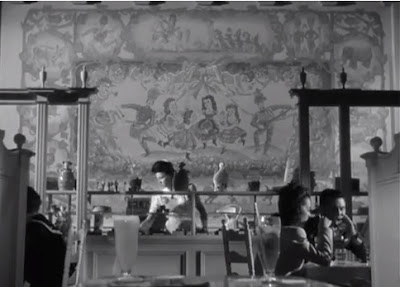Moments and Glances
Dennis's post about the Comedy Central short film, and his reference to Chuck Workman, caused me to mosey over to YouTube, to see if they had the short film shown above. I'd initially seen it in truncated form on TCM years and years ago, and had always enjoyed it. What does it mean to summarize (primarily) Hollywood history in nine minutes? How do we mark and delineate years or periods (does it matter if a clip falls before or after the year emblazoned upon the screen: "1948," "1976," etc.)? On the American Masters documentary about Tony Bennett earlier in the evening, Jonathan Schwartz mentioned that Bennett had graduated from being a "short-story author" (a singer of individual pop hits) to a "novelist" (who could sustain a mood or theme over a whole concept album). Workman's film is definitely the "pop single" version of Hollywood history-- a montage of mostly greatest hits, rather than rarities or relative "obscurities"-- which, in an age of Netflix and downloads, might feel outdated; we certainly have greater access to a wider range of films now than in 1994, when this short was made. But I'm not sure that limits Workman's achievement: for me, what's always been enjoyable about this film is the link, how Workman transitions from one moment to the next: on a face, a snatch of dialogue, a visual rhyme (such as the cut from Frankenstein's gothic technology to the whoosh! of the Berkeley chorus girl shooting up through the hole in the floor in 42nd Street, as if popping out of the good doctor's machine on cue: "It's alive!!"). Compressed, forced to summarize a history through faces, glances and gestures rather than full narrative, Workman seems to be working through a more cinephiliac organizational pattern, similar to that described by film scholar Christian Keathley:
The links between the cinema, personal memory, the anecdote (metonymy) and the uncanny are strong—indeed, uncanny...From the specific moment, the cinephile moves metonymically, partly into personal recollection, partly into public information and history, until the snap of the uncanny is encountered.
These personal memories, Keathley notes, are driven by images, often wrenched out of their context, and able to rhyme themselves across several films or periods: he cites Lesley Stern's work on Blade Runner, and how the image of Pris back-flipping leads Stern through a metonymic discourse that includes any number of classic films that contain similar images or moments (for a stimulating discussion of Keathley's use of "cinematic moments," see this excellent Girish post from 2006).
One of the questions Keathley poses is how this "snap of the uncanny" might function in criticism. Workman's film, however standard in its content, might be one model, but so is the blog post itself, and its rerouting and relinking of ideas (this post itself inspired by something tangentially related on SLIFR, which links back to...etc.). It's what Jeff notes as the way one link can carry you to the next, without needing to fit a pattern of conventional wisdom: "...a fascinating Web," Jeff writes, "one not driven by literary production or aesthetics or profoundness or the political. But one more akin to the canonical Arcades Benjamin romanticized or the drift Barthes encourages." Benjamin: "I need not explain. Only show." Faces, glances, epiphanies, pulses, "moments of recognition" (as Sarris calls them in "Notes on the Auteur Theory"): writing as desire, history as desert island disc.


Comments
I don't know-- it'll probably still be there. I like Workman's clip montages, too, and think this one is particularly nice.
No, you're right, and it's a great observation, esp. given how Kane itself is playing with notions of memory and metonymy (and that play between a written and visual language-- the music starts as thompson is looking at the diary, we get a close-up on the words, then a visual "translation" of them as we move to the-- what? Flashback? Remembrance? Self-justifying diary? All three and more?)